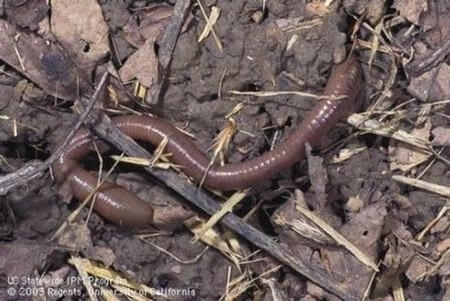Perhaps you've seen them. You're digging into the soil to plant something and as you dig you run across a few earthworms. Most of us have heard from childhood that worms are good for the soil. You may also be aware of vermiculture, or worm composting, using worms to help turn organic waste into nutrient rich compost for the soil. When you see earthworms in your garden, what does their presence suggest about the soil health? Should you add more?
Earthworms and Wigglers
The earthworms you typically see in your garden are considered "migratory" which means they will travel to find the habitat best suited to their success. They tend to cluster in the top 6 to 8 inches of soil around the roots of plants where they feed on decaying material and the fungi and other organisms that live there. As they travel through the soil, they drag leaves and other litter down into their burrows where soil microorganisms also begin digesting the material. These worms can tolerate colder temperatures through the winter months when they burrow deeper into the soil.
Earthworms need a light airy soil and rely on decaying organic material for nourishment. Introducing these earthworms to an inhospitable environment such as heavy clay, or compacted and/or dry soil, will result in them either leaving or dying. Where they flourish, however, they are important in mixing the dead surface litter with the main body of the soil. If you regularly add compost and a layer of mulch to your garden to improve the soil you may find the worms 'magically' appear, attracted to the habitat you are creating. In turn their constant burrowing and feeding activities help mix and distribute organic matter throughout the soil, improve soil aeration and water penetration, promoting a healthier root environment for your plants. Their excrement, known as castings, is richer in nitrogen, potassium carbon, sulfur, and other minerals than the rest of the soil, and acts as a natural fertilizer.
There is a second type of worm which lives close to the soil surface in areas of abundant organic material. These worms, including the popular species red wigglers, reproduce rapidly and thrive in warm, crowded conditions. They are less likely to survive in your garden environment, particularly during cold weather. Instead, these worms are ideally suited to worm bins, and you will usually find them for sale for use in vermiculture. In a bin they can rapidly break down food scraps and other organic waste materials, and their castings also act as a natural fertilizer when collected and added to garden soils. Think of these worms as composting specialists.
A Note of Caution
There is a type of worm known as a jumping worm, an invasive species capable of harming native forests which has been seen in California and many other states. It is recognizable by a milky-white band wrapping all around its body near the head. When disturbed, jumping worms have been known to throw themselves into the air and thrash around. It is very difficult to eliminate these worms once established, so make sure to check new mulch, compost, and potting soil for the worms, as well as soil in nursery pots. Because they live close to the surface their castings are often visible as a coffee-ground-like substance on the soil. Don't use these worms for fishing, vermiculture, or gardening. You can learn more about jumping worms at https://ucanr.edu/blogs/blogcore/postdetail.cfm?postnum=56929.
The Bottom Line
Should you add worms to your garden soil? Ultimately, it's a chicken and egg situation. Do earthworms create healthy soil or are they attracted to healthy soil? Few valid studies have been done to link the presence of earthworms with improved plant growth. However, both plants and earthworms need temperatures between 60°F and 100°F, water (but not too much or too little), oxygen, and a soil that isn't too acidic, basic, or salty. It's clear the conditions that are good for plants are also good for earthworms, and improving your soil by regularly adding compost and mulch ends up supporting a thriving community of both healthy plants and earthworms.
Help Desk of the UC Master Gardeners of Contra Costa County (RDH)
